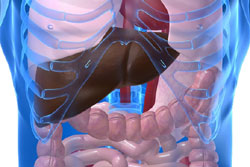Liver biopsy is a valuable investigation to help diagnose disease of the liver. The liver is the large glandular organ located below the ribs on the right side of the body. It has many important functions in filtering out toxins, digestion, storage and synthesis of proteins. The liver can be affected by numerous diseases such as viral hepatitis, alcoholic hepatitis, cirrhosis and cancers. Liver biopsy is used to take a small sample of liver tissue to determine whether these diseases are present, as well as their extent and severity. Liver biopsy can also be used to measure the response of the liver tissue to treatment and monitor the development of disease. Liver biopsy is used in conjunction with blood tests such as liver function tests and X-rays and imaging of the abdomen.
What is a liver biopsy?

Percutaneous biopsy
Liver biopsy must be performed at a hospital by experienced doctors. Percutaneous biopsy is the most commonly used method which inserts a needle through the skin to the liver. For this procedure, you lie on your back and the doctor traces out the location of the liver by either tapping it or using ultrasound. Then the physician will find the appropriate spot to inject the local anaesthetic into the liver capsule (a thick fibrous coat on the liver). This numbs the area so they can make a small cut with a scalpel between the ribs, and insert the needle. The middle of the needle takes some liver tissue out with it when it is withdrawn. Usually this will not produce any pain but you may experience some discomfort. Sometimes patients are sedated for the procedure, but most of the time you be awake and the physician will require you to assist them in the procedure. You will have to lie very still and hold your breath for approximately 10 seconds whilst they insert the needle. If you fail to follow the instructions correctly, there may be damage to surrounding structure and other complications. You will get to practice appropriate breathing a few times before the needle is inserted! The entire procedure usually takes 20 minutes.
Transjugular biopsy
Other methods of biopsy are also available. For transjugular biopsy, a thin tube called a catheter is inserted into the internal jugular vein in your neck. This tube can be threaded through blood vessels all the way to the liver. A needle is then passed down the catheter to the liver so a sample can be taken. This is used in patients that are very overweight, have severe ascites (fluid in the abdomen) or have bleeding disorders.
Laporascopic biopsy
Laporascopic biopsy uses a special tube called a laporoscope, which is inserted through a cut in the abdomen. This device has a camera so it can be used to locate specific sites of the liver where a sample is wanted.
Fine needle aspirate biopsy
Finally, fine needle aspirate biopsy is used to sample specific lesions found on imaging. Again a needle is inserted into the lesion and a small sample of tissue is aspirated (or sucked) into the needle. Following the procedure, a bandage is placed over the needle site and you will have to lie on your right side for 2 hours. You then will have your pulse and blood pressure checked regularly for at least another 6 hours in the hospital so any problems can be detected early and treated. You will also be advised to rest for several days after the procedure and may be prescribed medications to treat any pain following the procedure.
How to prepare for a liver biopsy
Prior to the procedure being booked, the physician will do blood tests to ensure your blood clots properly. You will also have to stop taking any medications that may increase bleeding one week before the procedure. The physician will explain the specific reasons for you having the procedure, the process and possible complications so you understand. You will then have to sign a consent form. For eight hours prior to the procedure you will not be allowed to eat or drink anything as this reduces the risk of aspiration (sucking of gastrointestinal contents into the airways) during the procedure.
Indications

- Diagnosis, grading and staging of alcoholic liver disease, nonalcoholic steatohepatitis (fatty liver) and autoimmune (self-destruction) hepatitis which are some of the most common causes of chronic liver disease. Hepatitis basically refers to inflammation of the liver which can be caused by various noxious agents.
- Grading and staging of chronic viral hepatitis (either hepatitis B or C). Hepatitis C is the most common cause of chronic liver disease in our community and may lead to cirrhosis or hepatocellular carcinoma.
- Liver biopsy may be done to obtain a diagnosis in patients with unexplained hepatomegaly (enlarged liver), persistently abnormal LFTs and unexplained jaundice (yellow discolouration of the skin and whites of the eyes). In particular, liver biopsy can be used when other investigations are inconclusive.
- Diagnosis of hereditary haemochromatosis by examining iron levels in the liver. In particular, liver biopsy is used in the screening of relatives with this condition.
- Diagnosis of Wilson’s disease by measuring copper levels in the liver.
- Evaluation of a hepatic mass and for the diagnosis of primary (originating in the liver) or secondary (arising somewhere else and spreading to the liver) carcinoma (cancer).
- Evaluation of obstructive liver diseases including primary biliary cirrhosis and primary sclerosing cholangitis.
- In liver transplantation to determine the suitability of the donor liver and to monitor the liver post transplantation.
- Investigation of pyrexia (fever) of unknown origin. Tissue samples can be cultured to determine causative organisms for infection and fever.
- Diagnosis of drug-induced liver disease.
Even for patients in whom the diagnosis of a specific liver disease is quite obvious, liver biopsy can provide additional information about stage, prognosis and response to treatment.
Complications

- Local abdominal or shoulder pain which is often minor and can be relieved with analgesics (pain medications). Many patients just experience mild discomfort at the biopsy site.
- Mild and transient hypotension (drop in blood pressure).
- Bleeding into the abdominal cavity (<0.5%). Risk factors for bleeding include older age, large number of passes with the needle and presence of liver cirrhosis or carcinoma.
- Puncture of the lung or other organs
- Infection that can spread into the blood stream.
- The mortality rate of liver biopsy is less than 0.1%
References
- Braunwald, Fauci, Kasper, Hauser, Longo, Jameson. Harrison’s Principles of Internal Medicine. 15th Edition. McGraw-Hill. 2001.
- Bravo A, Sheth S, Chopra S. ‘Liver biopsy.’ The New England Journal of Medicine. 2001, vol. 344, no. 7, pp. 495-500.
- Kumar, Clark. Clinical Medicine. 5th Edition. Saunders. 2002.
- Longmore, Wilkinson, Rajagopalan. Oxford Handbook of Clinical Medicine. 6th Edition. Oxford University Press. 2004.
All content and media on the HealthEngine Blog is created and published online for informational purposes only. It is not intended to be a substitute for professional medical advice and should not be relied on as health or personal advice. Always seek the guidance of your doctor or other qualified health professional with any questions you may have regarding your health or a medical condition. Never disregard the advice of a medical professional, or delay in seeking it because of something you have read on this Website. If you think you may have a medical emergency, call your doctor, go to the nearest hospital emergency department, or call the emergency services immediately.








